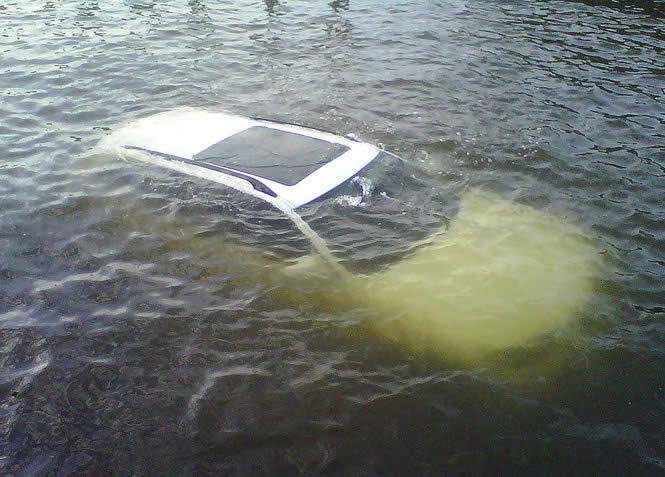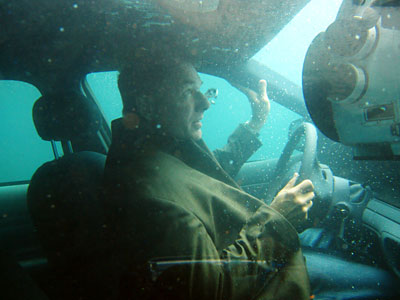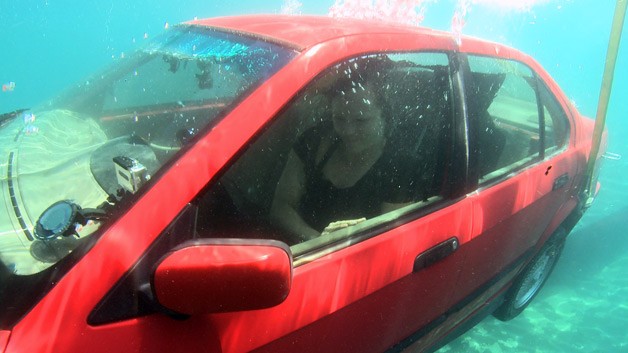The proper approach to take when an occupied vehicle is submerging is controversial. Numerous popular media and supposed experts have offered strategies that may be more likely to kill occupants than save lives. Happily, some evidence is being brought to this question. Hopefully this article will help separate myth from evidence and lead to safer procedures when a vehicle is submerging, whether you are a rescuer or an occupant.

Submersion in vehicles as a cause of death by drowning is not routinely classified as a drowning death (1). However, in one series, the incidence of drowning in motor vehicle accidental deaths was as high as 5-10 percent, especially during disasters (e.g., temporary wilderness!) (2,3). We know that even under normal non-disaster situations the motor vehicle accidental death rate is extremely high. In addition, motor vehicle submersions are responsible for approximately 10 percent of all drowning incidents (4,5,6), a statistically significant source of drowning incidents. The fact that it is a common problem, that popular wisdom about how to manage it is wrong, and that there is a specific intervention proposed for mitigating this fatality rate that appears more correct (14), all make it a perfect topic for our Wilderness Medicine Drowning column!
You might ask if this is, in fact, wilderness medicine. Here's your answer!
"Is this, in fact, a wilderness medicine topic? Mechanized equipment like boats, cars, and other vehicles are often a component of wilderness recreation. We don't exclude boats from discussions about the wilderness medical care of drownings (7). We don't exclude snowmobiles from discussions about wilderness medical care of ice and snow travel (4). We even discuss vehicle survival and vehicle hazards related to space flight within the purview of wilderness medicine (8). For the same reason, I don't think we should exclude cars. In terms of significance (relative to, say, snowmobiles and spaceships), drowning incidents and motor vehicle crashes represent the first and second leading causes of accidental traumatic death in many age groups and most countries. If truly approximately 10 percent of motor vehicle crash fatalities during disasters are drowning incidents, and approximately 10 percent of drowning incidents are in motor vehicle crashes, this represents a hugely significant public health issue. In fact, motor vehicle travel is sometimes identified as the single most dangerous portion of a wilderness trip."
This first became a significant topic in American national dialogue in February 2001 when Karla Gutierrez drowned in a Miami-Dade County canal. Amazingly and tragically, she was on the phone with a 911 dispatcher for over three minutes as her car sank (29). She was a drowning death once it was submerged. Sadly, these incidents continue to appear every year where callers die of drowning while on the phone with 911 in a submerging vehicle, often for three minutes or more (31). One particularly tragic case occurred in 2013 with a wilderness medicine twist. In this case, two hikers were rescued after they got lost in the dark. One was pregnant. Because it was so dark, after being rescued, they made a wrong turn in their car, drove off a dock and their vehicle became submerged in a lake. They had time to call 911 and were getting instructions when their line went dead (30). Both died of drowning.
Recently, I became certified by North Carolina as an Emergency Medical Dispatcher (EMD), and I'm currently one of the few physicians in the United States to pursue ongoing credentialing as both an MD and an EMD. In this context, I was able to explore much deeper some of the protocols for handling submerged vehicle drownings.
Here is a more detailed discussion of the topic of 911 dispatch implication.
"The Medical Priority Dispatch system, under Dr. Jeffrey Clawson's medical direction, is one of the most commonly used dispatch protocols in the country by formally certified Emergency Medical Dispatchers. Following these many incidents, they developed an extremely rare pull-out card (only a couple exist in the entire card-based protocol system) instructing EMDs not to get a location for a submerging vehicle, and instead to have a caller get out of the vehicle if it is submerging. A significant amount of space in the very limited card-based protocols are dedicated to this intervention, recognizing, I believe, the relatively high fatality rate and the available lifesaving intervention, and also recognizing that the time spent determining location by an EMD can result in the patient's unnecessary death (14). There are a few things that an EMD can do in a matter of minutes that can save lives; they have recognized that this is one of those interventions."
There is a small but existent body of peer-reviewed literature addressing submersions (9,10,11,12,13). A formal review of educational and public service information, including a public survey, identified "three probable significant contributors to [the] high fatality rate [of drowning in submerged vehicles]: 1) 'authorities' provide an inadequate description of vehicle sinking characteristics; 2) contradictory and inadequate advice is often provided; and 3) a poor public perception of how to escape" (14).
Specifically, several sources recommend questionable practices that expert analysis suggests potentially increases rather than decreases risk of fatality, including most often letting the passenger compartment fill with water so that it will be easier to open the doors, wait until the vehicle hits the bottom to maintain orientation, relying on kicking out the windshields, opening the door to exit, and reliance on breathing trapped air in the passenger compartment (15,16,17,18,19,20,21,22,23). These are often perpetuated by media outlets (24,25,26,27,28). In a formal survey, half or more of the general public identify an option that involves staying in a vehicle while it sinks to the bottom as being the safest option when trapped in a submerging vehicle (14).

Doctor Gordon Giesbrecht has conducted well-designed research including 35 vehicle submersions in multiple locations and seasons. His research suggests that these perceptions of submerging vehicle characteristics, along with their associated survival strategies, are erroneous. He proposes alternate strategies and education to reduce fatality (14).
His data demonstrates that a vehicle floats for between 30 seconds to two minutes prior to sinking. In this phase, windows can be easily opened and used for exit, assuming the risk outside the vehicle is not greater than the risk inside the vehicle (e.g., swiftwater or a non-swimmer exiting into deep water). In one trial, three adults were able to exit a single vehicle, including the release of a child manikin from a rear child seat, within 51 seconds. During the sinking phase (after two minutes) occupants can breath as water rises inside the vehicle, but he notes that chances for escape and survival decrease considerably during this phase as doors and windows became less available as egress sites due to rising water pressure. In the third, submerged phase, the vehicle is full of water and no air pockets exist, where the chance of survival is negligible.
Giesbrecht writes:
It is important to inform and train the public of these factors so that they become second nature. This will greatly increase the probability of persons initiating the proper exit strategies when faced with an emergency situation with little time to think rationally of a course of action. Clearly the best time to escape from a vehicle is immediately during the initial floating phase. The following escape procedure should be followed:
• Seatbelts: unfastened
• Windows: open
• Children: if present, released from restraints and brought close to an adult who can assist in their escape
• Out: children should be pushed out of the window first, and followed immediately (14)
Giesbrecht has convinced me, as well as other national bodies like the Medical Priority Dispatch System. We're sharing it with you in case it is equally convincing.

I think we need to recognize that, in the new era of telecommunications, many of our wilderness medical patients are actually in communication with a 911 dispatcher during their wilderness or environmental emergency. This is certainly the case in my experience, where our team covers the deepest gorge in the eastern United States and the largest state park in N.C., and yet many of our patients established mobile phone contact with a dispatcher, and sometimes keep that contact for many minutes or even hours. In the wilderness medical community we need to use that new technology to consider if there are EMD-based interventions that can be done to prevent morbidity and mortality, even if 911-based interventions are historically not a typical part of wilderness medical operations. I believe this is one of those cases.
Published on February 26, 2015
References:
1: Cushing TA et al. "Submersion Injuries and Drowning" in Wilderness Medicine 6th ed, Auerbach PS, ed. Philadelphia: Elsevier, 2012: 1496.
2: Yale JD, Cole TB, Garrison HG, et al: Motor vehicle-related drowning deaths associated with inland flooding after Hurricane Floyd: A field investigation, Traffic Inj Prev 4(4):279, 2003.
3: Smith GS, Brenner RA: The changing risks of drowning for adolescents in the U.S. and effective control strategies, Adolesc Med State Art Rev 6(2):153, 1995.
4: Giesbrecht GG, Steinman AM. "Immersion into Cold Water" in Wilderness Medicine 6th ed, Auerbach PS, ed. Philadelphia: Elsevier, 2012: 142.
5: Transport Canada : Trends in motor vehicle traffic collision statistics 1988-1997. Transport Ottowa, Canada, 2001.
6: Wintemute GJ, Kraus JF, Teret SP, et al: Death resulting from motor vehicle immersions: the nature of the injuries, personal and enviromental contributing factors, and potential interventions. Am J Public Health 1990; 80:1068.
7. Cushing TA et al. "Submersion Injuries and Drowning" in Wilderness Medicine 6th ed, Auerbach PS, ed. Philadelphia: Elsevier, 2012: 1497.
8. Bacal K, Smart K. "Space Medicine: The New Frontier" in Wilderness Medicine 6th ed, Auerbach PS, ed. Philadelphia: Elsevier, 2012: 2200,2202.
9. Lunetta P, Pentilla A, Sajantila A. Drowning in Finland: "External Cause" and "Injury" Codes. Injury Prevention, 2002. 8: 342-344.
10. Wintemute GJ et al. Death Resulting from Motor Vehicle Immersions: the Nature of the Injuries, Personal and Environmental Contributing Factors, and Potential Interventions. American Journal of Public Health, 1990. 80(9):1068-1074.
11. French J et al. Mortality from flash floods: a review of national weather service reports, 1969-1981. Public Health Reports, 1983. 98(6):584-588.
12. Agocs MM, Trent RB, Russell DM. Activities associated with drownings in Imperial County, CA, 1980-1990: implications for prevention. Public Health Reports, 1994. 109(2):290-295.
13. Lobeto A. Engine Company Operations: Vehicle Accidents in Water, in Fire Engineering. 2003, FireEngineering.com.
14. McDonald GK, Giesbrecht GG. Vehicle submersion: a review of the problem, associated risks, and survival information . Aviat Space Environ Med. 2013; 84:498 – 510
15. If you go in, you can get out…if you know how, in Family Safety. 1969:20-22.
16. Dworkin G. Rescue from submerged vehicles. 1998, Lifesaving Resources Inc.
17. Borgenicht JPD. How to escape from a sinking car, in The Worst-Case Scenario Survival Handbook. 1999, Quirk Productions: San Francisco, CA: 36-38.
18. TBS, Worst Case Scenario, in How to Escape from a Sinking Car. 2002, Turner Broadcasting System: USA.
19. Lifesaving Society. C: Breaking Through: Fundamentals of Ice Rescue, Ice The Winter Killer (A resource manual about Ice, Ice Safety, Ice Rescue), 2003, Lifesaving Society: Ottawa: 55-67.
20. Dworkin, G, Rescue from Submerged Vehicles. 2004, techrescue.org
21. Farlam J. Escape from a sinking car, in Smart Driving. 2004, www.smartdriving.co.uk.
22. Kendall, et al. A sinking car, in The Five-Minute Guide to Surviving Everything. 2004.
23. MPI, Vehicle plunging into water, in Driver's Handbook. 2006, Manitoba Public Insurance, 96.
24. Orphan D. Cheating Death: how to escape from a submerged automobile, in Today's Health. 1961. 32-33, 82.
25. Fox A, WAVY TV, in Road Rebels: Great Escapes. 2001, Video Atlantic Teleproductions: USA.
26. Cannon L, NBC Dateline, in Life on the Line. 2001, NBC:USA.
27. Winfrey O. What Should You Do? in The Oprah Winfrey Show. 2003, Harpo Productions, Inc: USA.
28. Sastre J. Handling Submerged Vehicle Incidents. 2001, Dispatch Monthly Magazine: www.dispatchmonthly.com p 3.
29. Woman Drowns in Canal after 911 call. Dispatch Magazine. Available at http://www.911dispatch.com/video/miami/ Accessed 8/11/13.
30. Maine hikers drive to ocean deaths after being rescued. FoxNews.Com, July 25, 2013. Available at http://www.foxnews.com/us/2013/07/25/maine-hikers-drive-to-ocean-deaths-after-being-rescued/ Accessed 8/11/3
31. Clark M. Sink to your death: agencies do little to ensure motorists escape sinking cars. Posted Dec 11,2010. Available at http://www.naplesnews.com/news/2010/dec/11/florida-drown-car-canal-lake-fatal-Mary-Catania/ Accessed 8/11/13